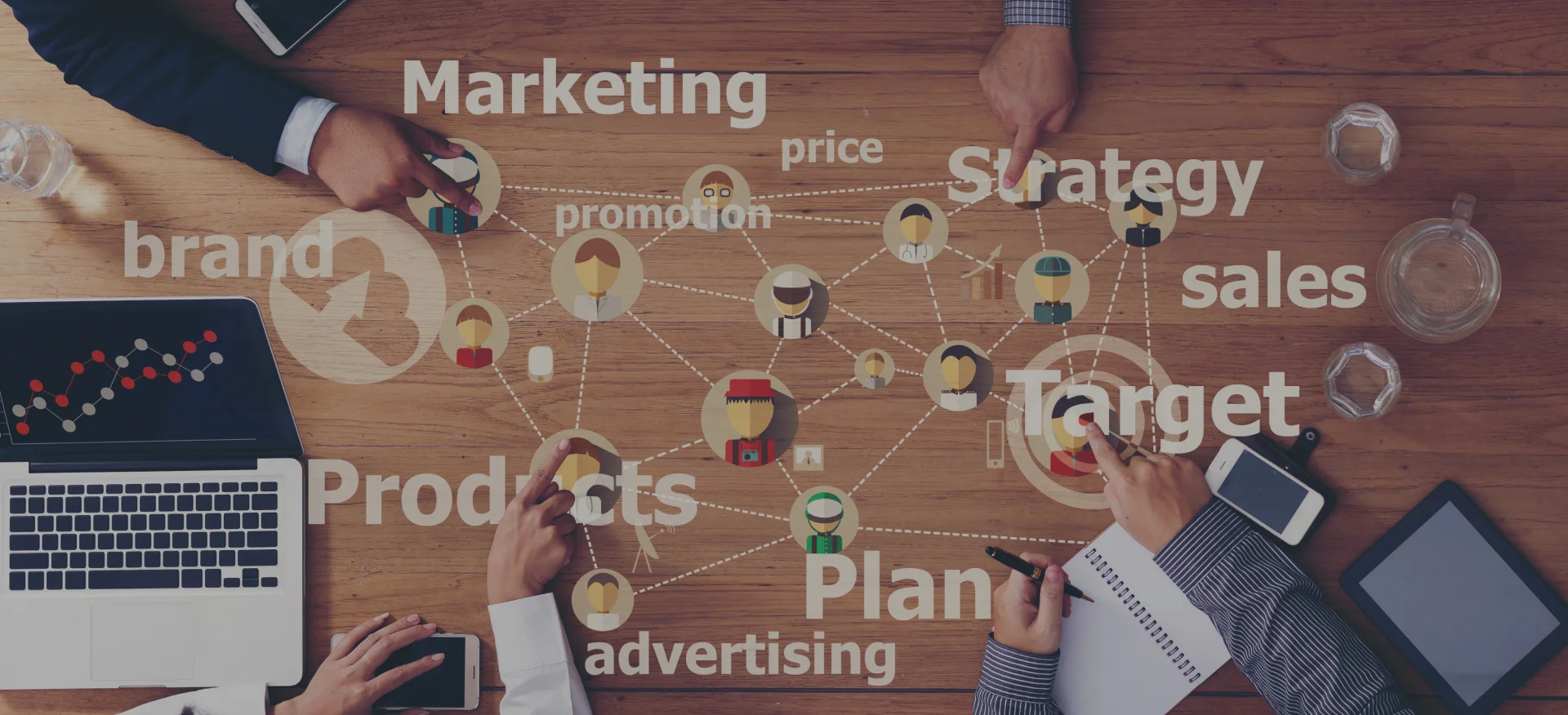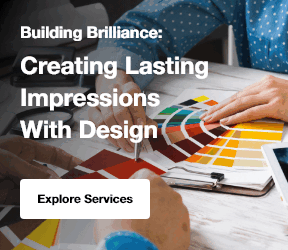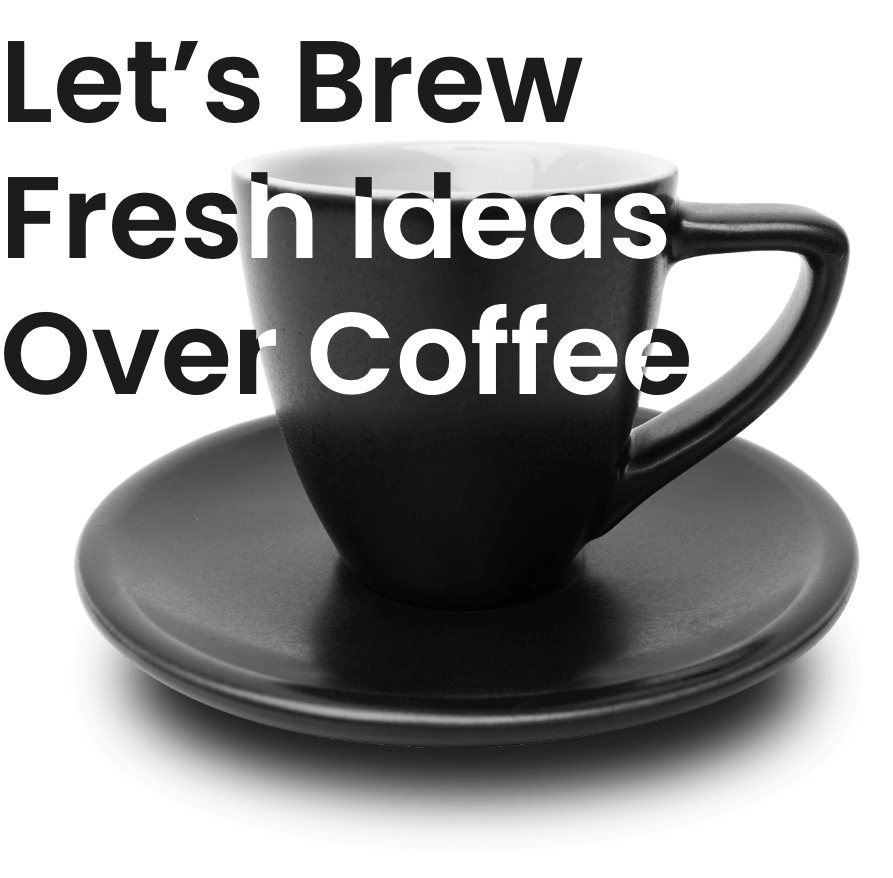In today’s digital-first world, advertising is more than just placing ads in front of people, it’s about crafting a strategic, data-driven approach that connects with the right audience at the right time. With global digital ad spending expected to surpass $700 billion in 2024, businesses are under increasing pressure to ensure that every marketing dollar delivers measurable results.
However, without a well-planned advertising strategy, companies risk wasting valuable resources on ineffective campaigns. Research shows that brands with a clear advertising strategy see up to 30% higher ROI than those without one. This blog explores the essential components of successful advertising strategies, offering insights into creative, data-driven campaigns that boost engagement, sales, and long-term brand growth. Whether you're a small business or a global enterprise, understanding and implementing the right advertising strategy is key to staying competitive in an ever-evolving marketplace.
What Are Advertising Strategies?
Advertising strategies are deliberate, research-driven plans brands use to communicate their value, reach the right audience, and drive measurable actions like sales, sign-ups, or engagement. A strategy goes beyond simply running ads; it’s about understanding customers, choosing the best channels, shaping a message that resonates, and refining performance with data.
Without a solid plan, companies risk wasting money on poorly targeted ads or inconsistent messaging. In today’s competitive, fast-changing media environment, having a well-built advertising strategy is the difference between campaigns that simply exist and campaigns that generate impact, ROI, and loyalty. For example, what are five marketing strategies that retailers spend half of their annual budget on? These strategies often include paid media like social ads, search ads (pay-per-click) campaigns, performance-driven initiatives, and more.
What Makes an Advertising Strategy Successful?
A successful advertising strategy effectively aligns with business goals, engages the target audience, and adapts based on data and insights. It combines creativity with measurable results to drive meaningful impact and achieve desired outcomes. Moreover, integrating growth marketing strategy principles ensures that each tactic is scalable, sustainable, and focused on long-term growth.
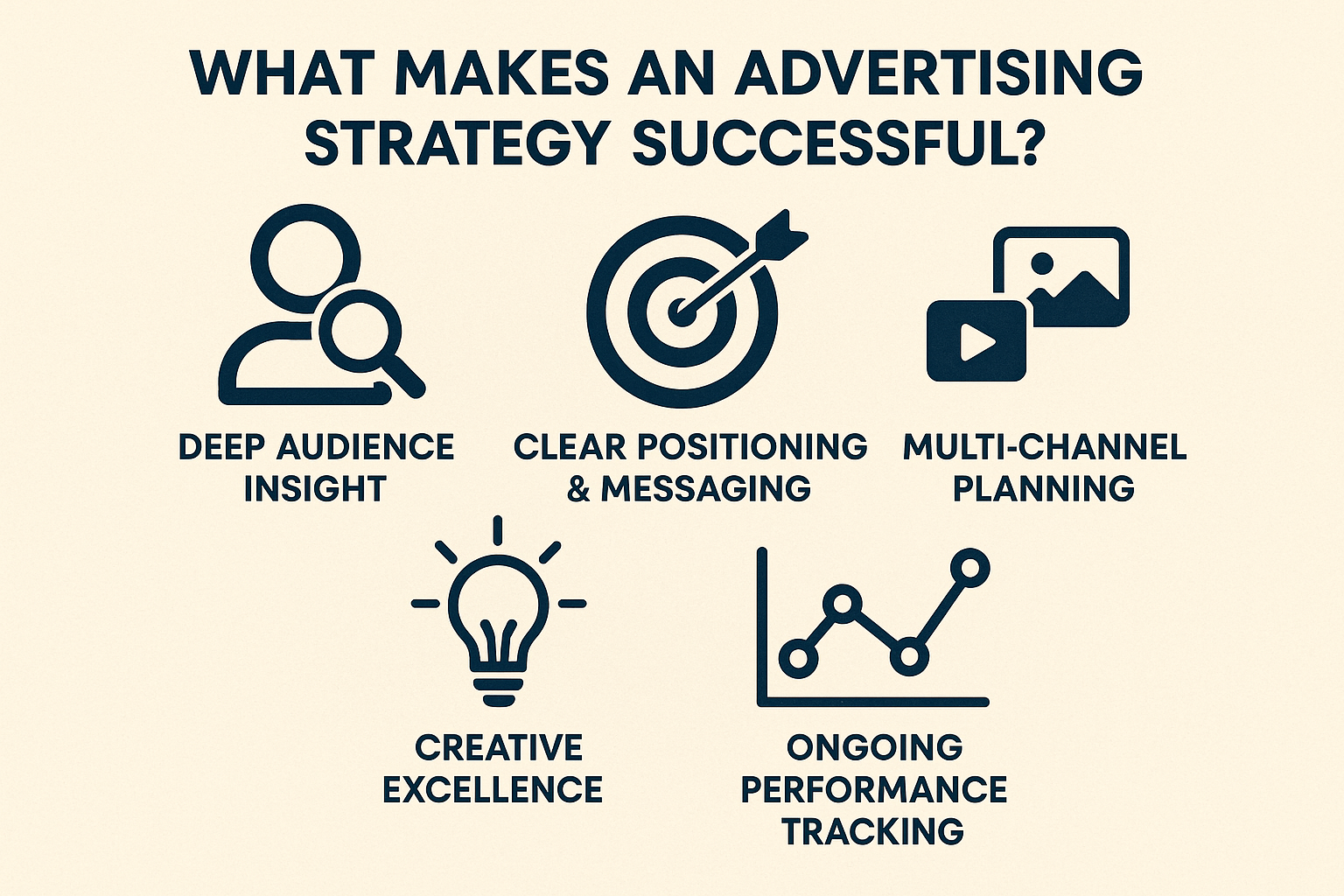
A successful strategy combines creativity and data-driven decision-making.
It includes these critical pillars:
1. Deep Audience Insight
Effective advertising starts with understanding your ideal customers, their motivations, preferences, habits, and even frustrations. This insight shapes every part of your campaign, from copy to channel selection.
2. Clear Positioning & Messaging
Your strategy should clearly define why your brand matters and how it’s different from competitors. A strong USP (unique selling proposition) sets the tone for compelling, relevant ads.
3. Multi-Channel Planning
Your audience might be on Instagram, LinkedIn, YouTube, or the radio. A great strategy balances where they are with where your budget performs best, creating a unified experience.
4. Creative Excellence
Powerful visuals, compelling headlines, and storytelling connect emotionally and make your ads stand out in crowded spaces.
5. Ongoing Performance Tracking
A great strategy never “sets and forgets.” It measures CTR, ROAS, and conversion rates, optimizing for better results over time.
If your campaigns feel inconsistent or underperform, expert Digital Marketing Services can help you create a cohesive, results-driven advertising roadmap.
Explore Our Performance Marketing Services!
13 Types of Advertising Strategies
Different business goals require different advertising approaches:
1. Brand Positioning Strategy
This defines how your audience should perceive your brand. For instance, Volvo has positioned itself around safety, while Nike stands for empowerment and achievement.
2. Content-Driven Strategy
Brands share valuable, entertaining, or educational content, like videos, blogs, and how-to guides, to build trust before making a direct sales pitch.
3. Direct Response Strategy
This approach seeks immediate action: click, buy, sign up, or download. It uses urgency and clear CTAs such as “Shop Now” or “Get 20% Off Today.”
4. Emotional Branding Strategy
Stories that tap into feelings, hope, nostalgia, and a sense of belonging help brands build lasting emotional bonds with customers.
5. Influencer & Partnership Strategy
Brands team up with trusted voices in their niche to build credibility and reach new audiences through authentic advocacy.
6. Performance Marketing Strategy
This pay-for-results model is focused on ROI. Brands invest in measurable actions like leads, purchases, or downloads.
Industries with complex B2B buyers, such as energy or exploration, thrive with help from an oil and gas marketing agency that understands niche decision-making cycles.
7. Social Media Advertising Strategy
Leveraging platforms like Facebook, Instagram, LinkedIn, and Twitter to create targeted ads based on demographics, interests, and behaviors. This strategy allows for real-time interaction with your audience and enhances brand visibility.
8. Search Engine Marketing (SEM) Strategy
This strategy involves using paid ads on search engines like Google or Bing to increase visibility. It’s closely tied to SEO (Search Engine Optimization) but focuses on bidding for keywords and appearing in paid results.
9. Retargeting & Remarketing Strategy
Retargeting focuses on reaching people who have already interacted with your brand but didn’t convert. It uses cookies to track users’ behavior and shows them personalized ads, nudging them to revisit and complete their purchase.
10. Guerrilla Marketing Strategy
This unconventional approach relies on surprise, creativity, and high energy to capture attention. It often includes flash mobs, public art, or other viral tactics that leave a memorable impact on audiences.
11. Native Advertising Strategy
Native ads blend seamlessly with the content around them, making them less intrusive. Examples include sponsored blog posts or videos that resemble editorial content, creating a non-disruptive experience for the viewer.
12. Affiliate Marketing Strategy
Here, businesses collaborate with affiliates or influencers who promote their products in exchange for a commission. This performance-based model works well for driving sales through trusted third parties.
13. Experiential Marketing Strategy
Creating memorable experiences that allow customers to engage with your brand in-person or virtually. It could be a pop-up shop, a product launch event, or an interactive digital experience that leaves a lasting impression.
14. Seasonal or Event-Based Strategy
This involves creating campaigns that tie into specific seasons, holidays, or events. For instance, offering discounts during Black Friday or Christmas or creating special promotions around local festivals or events.
13. Video Marketing Strategy
Using video content for promotions, ads, or brand storytelling. This can include everything from social media stories to YouTube ads, tutorials, and product demonstrations, tapping into the growing demand for visual content.
These additional strategies offer a more expansive approach, covering digital, experiential, and niche-driven marketing tactics to suit a broader range of business goals. Would you like to dive deeper into any of these strategies?
Explore Our Digital Marketing Services!
What Are the Benefits of a Well-Planned Advertising Strategy?
Strong strategies bring clear, measurable advantages:
- Increased Brand Awareness: Consistent and targeted advertising makes your business memorable and trusted.
- Better Audience Targeting: Smart segmentation ensures your message appears to those most likely to convert, reducing waste.
- Higher Conversion Rates: When creative and channels align, more viewers become buyers or subscribers.
- Efficient Budget Allocation: Data-driven planning avoids spending on low-impact channels.
- Sustainable Long-Term Growth: Cohesive strategies create a trustworthy brand voice and build customer loyalty beyond a single campaign.
For consumer-driven brands like restaurants or packaged foods, working with a food and beverage branding agency ensures campaigns feel irresistible, flavorful, and emotional.
What Challenges Do Marketers Face in Advertising Strategy?
Even skilled marketers encounter roadblocks:
- Market Saturation: Standing out among numerous ads requires creativity and a strong brand positioning.
- Shifting Consumer Preferences: Platforms rise and fade, and trends change rapidly.
- Ad Fatigue: Audiences tend to skip or ignore repetitive, uninspiring campaigns.
- Complex ROI Measurement: Multi-channel attribution can lead to confusing results.
- Budget Pressure: Rising ad costs demand smarter allocation.
Travel and hospitality brands overcome these issues by collaborating with a travel marketing agency that utilizes destination storytelling and precise targeting to spark wanderlust while optimizing their spend.
What Are the 5 Best Practices for Building an Advertising Strategy?
Creating a long-term campaign requires a structured approach.
1. Define Clear Objectives
- Why: Set clear goals (e.g., awareness, leads, conversions) to guide your messaging and channel choices. For instance, performance marketing models work well when the objective is direct sales or conversions, using detailed tracking for ROI optimization.
- Example: If you want to boost website visits, set a specific target (e.g., 20% increase in traffic in 3 months).
2. Build Detailed Buyer Personas
- Why: Know your target audience, age, interests, habits, so ads feel personal and relevant.
- Example: Create personas based on demographics and behaviors, like targeting eco-conscious individuals for sustainable products.
3. Develop a Unique Value Proposition (UVP)
- Why: Clearly explain why your brand is different and what benefits it offers over competitors.
- Example: A UVP for a delivery service could be: "Fast, eco-friendly delivery at a competitive price."
4. Use Data to Guide Creativity
- Why: Analyze past data to see what works and adjust creative content accordingly for better results.
- Example: Use past ad performance to identify which images or headlines generated the most engagement.
5. Test and Refine
- Why: Continuously improve campaigns by testing different elements (e.g., visuals, CTAs) and optimizing based on results.
- Example: A/B test ad copy to determine which version drives higher click-through rates and adjust future campaigns accordingly.
This approach ensures your advertising strategy is focused, personalized, and always improving for better results.
Lifestyle and entertainment brands can sharpen their creativity and targeting by working with an entertainment marketing agency that understands storytelling and analytics.
What Role Does Creativity Play in Advertising Strategy?
Creativity is the human spark that turns data-driven plans into campaigns people remember.
- Capturing Attention: A bold idea, visual, or phrase stops the scroll and sparks curiosity.
- Building Emotional Connection: Stories and imagery that evoke joy, nostalgia, or aspiration drive deeper relationships.
- Increasing Memorability: Creative campaigns get shared, talked about, and remembered long after the ad ends.
Luxury brands depend on this emotional, artful storytelling. Partnering with a luxury branding agency helps maintain exclusivity while delivering measurable growth.
What Is the Difference Between Digital and Traditional Advertising Strategies?
Advertising strategies typically mix two core approaches: Digital Advertising and Traditional Advertising.
| Aspect | Digital Advertising | Traditional Advertising |
|---|---|---|
| Channels | Social media ads, search engines, display banners, email marketing, video platforms, podcasts, etc. | TV, radio, print (newspapers, magazines), billboards, direct mail, event sponsorship, etc. |
| Targeting | Highly precise targeting (age, gender, location, behavior, interests, etc.) | Broad targeting (demographics, mass audience, geographic area) |
| Cost | Lower entry costs, flexible budgets (pay-per-click, impressions, etc.) | Higher entry costs (production, airtime, distribution, etc.) |
| Measurement & Analytics | Real-time tracking of clicks, conversions, ROI, engagement, etc. | Harder to measure quickly (requires surveys, focus groups, and delayed data analysis) |
| Reach | Can target specific groups or regions with precision | Broad, mass reach – suitable for creating brand awareness across large populations |
| Interactivity | Allows for interaction and engagement (likes, comments, shares, clicks) | Limited interaction (viewing, listening, reading; no immediate feedback) |
| Flexibility & Speed | Highly flexible and adaptable (can change ads in real-time, run A/B tests) | Less flexible, changes require more time and cost (new print ad, rescheduling TV spots) |
| Longevity | Short-term campaigns, but can be ongoing with constant updates | Often has longer-lasting impact, especially in print media and billboards |
| Credibility | Varies depending on platform, sometimes seen as less trustworthy due to easy manipulation | Generally considered more credible (especially TV and print ads) |
| Creative Opportunities | Dynamic, allows for rich multimedia content (videos, animations, interactive banners) | Limited to static or video ads, less room for interactivity |
| Accessibility & Availability | 24/7, accessible worldwide as long as there’s internet access | Limited by geography and broadcast times, typically in specific regions/times |
| Examples | Facebook ads, Google search ads, YouTube video ads, Instagram stories, display banners on websites | TV commercials, radio ads, newspaper ads, billboards on highways, direct mail catalogs |
| Effectiveness | Highly effective for driving immediate action, direct sales, lead generation | Best for brand awareness, creating emotional connections, and long-term credibility |
Many brands blend both. Automotive companies often run TV spots to inspire emotion and use digital ads to drive immediate inquiries. An automotive marketing agency helps integrate these channels effectively.
What Tools and Technology Power Modern Advertising Strategies?
Today’s best strategies use technology to maximize efficiency and ROI:
- Ad Management Platforms – Google Ads, Meta Ads Manager, and LinkedIn Campaign Manager for campaign execution.
- Analytics Tools – Google Analytics, HubSpot, or Mixpanel to track engagement and conversions.
- Marketing Automation – Platforms like ActiveCampaign or Marketo to personalize communication.
- Creative Optimization Tools – AI headline testers, and video editors for A/B testing.
Real estate brands combine these tools to target buyers more precisely. A real estate marketing agency blends property storytelling with advanced targeting to boost conversions.
What Is the Future of Advertising Strategies?
The future of advertising is being shaped by technology, data, and changing consumer behavior. With innovations like AI, personalized content, and immersive experiences, brands are adapting to engage audiences in new and creative ways.
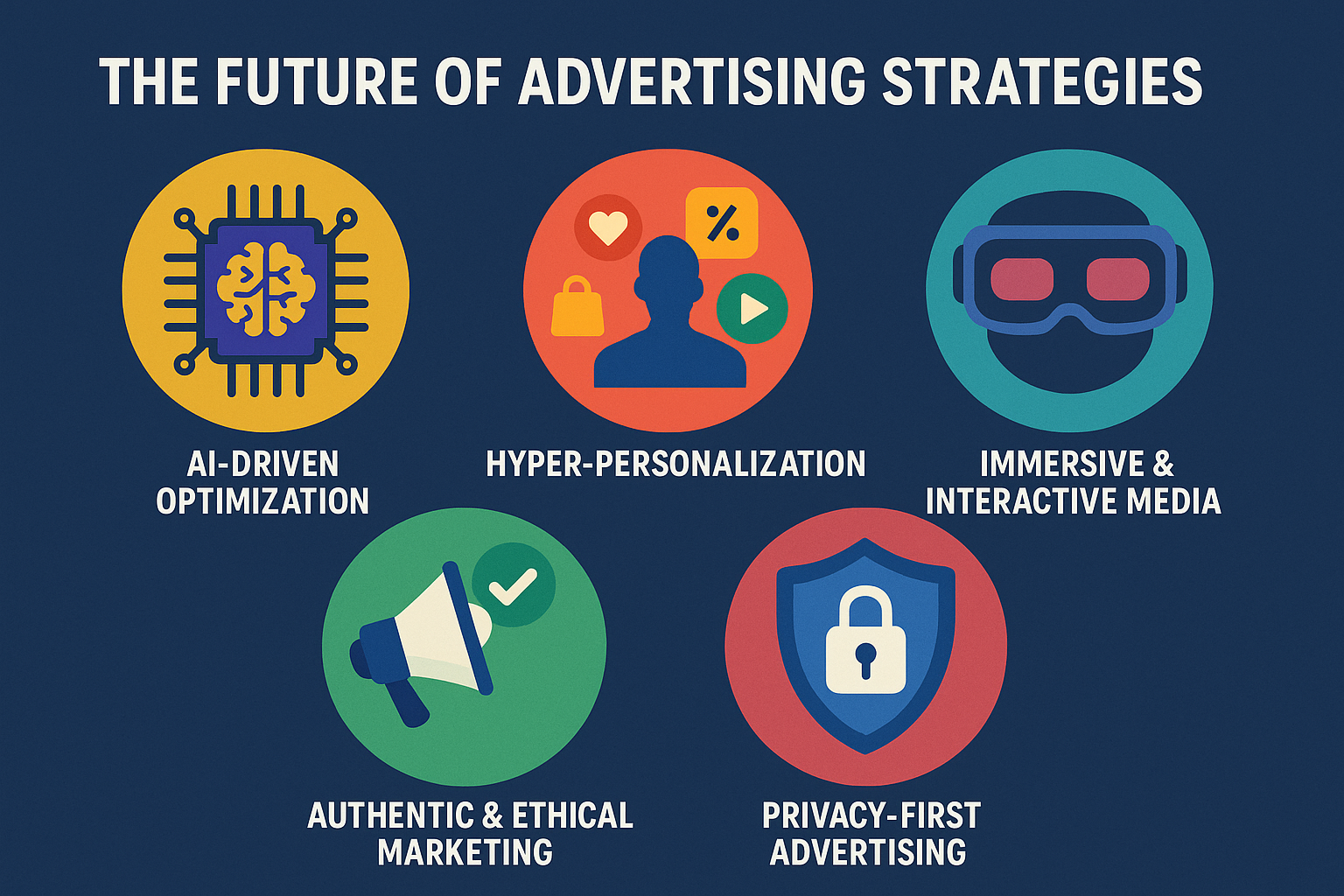
Advertising is transforming quickly, and brands need to prepare for these trends:
- AI-Driven Optimization: Artificial intelligence will predict user behavior, improving targeting and spend efficiency.
- Hyper-Personalization: Messages will shift from broad segments to individualized campaigns powered by data.
- Immersive & Interactive Media: AR, VR, and 3D experiences will make ads more engaging.
- Authentic & Ethical Marketing: Audiences demand transparency, inclusivity, and sustainable values.
- Privacy-First Advertising: With tighter data laws, contextual targeting and first-party data will take center stage.
Nonprofits can embrace these trends by combining data insights with heartfelt storytelling. A nonprofit marketing agency ensures campaigns stay authentic while leveraging new tech.
What 6 Metrics Should You Track for Advertising Success?
A data-driven strategy must measure impact. Key KPIs include:
- Click-Through Rate (CTR): Reveals how compelling your ads are in attracting clicks.
- Conversion Rate: Indicates the percentage of viewers who completed your desired action.
- Return on Ad Spend (ROAS): Indicates the overall profitability of your campaigns.
- Cost Per Acquisition (CPA): Tracks efficiency of turning viewers into customers.
- Engagement Metrics: Likes, shares, and comments gauge social resonance.
- Quality Score (Search Ads): Search engines reward highly relevant ads with lower costs per click.
Tech-driven companies benefit from a tech marketing agency to analyze data deeply and keep campaigns optimized.
6 Common Mistakes You Should Avoid in Advertising Strategy?
Avoid these pitfalls to protect your budget and results:
- Undefined Goals – Campaigns without objectives can’t measure success.
- Poor Audience Targeting – Wasted spend on the wrong people reduces ROI.
- Ignoring Mobile Users – Most consumers browse and buy on their phones.
- Skipping Testing – Guessing instead of A/B testing hurts performance.
- Generic Creative – Bland visuals and weak copy fail to stand out.
- Inconsistent Brand Voice – Confuses your audience and weakens trust.
Highly regulated sectors like finance can avoid compliance mistakes and build trust by working with a banking and financial marketing agency.
FAQ: Advertising Strategies
What is the main goal of an advertising strategy?
To reach and influence the right audience efficiently, boosting awareness, engagement, and conversions while controlling spend.
How is an advertising strategy different from a marketing strategy?
Marketing strategy covers the entire growth plan; advertising strategy focuses specifically on paid messaging, channels, and creative execution.
What’s the best advertising strategy for small businesses?
Direct response and content-led strategies work well because they’re cost-efficient and easily measurable.
How can I tell if my strategy is working?
Track metrics like CTR, conversion rates, ROAS, and CPA. Improvements signal campaign success.
Should I hire professionals for my advertising strategy?
Yes. Experts bring research, creativity, and optimization that save money and deliver stronger ROI.
Conclusion
In today’s hyper-competitive market, advertising isn’t simply about putting messages in front of as many eyes as possible; it’s about strategic precision, creativity, and continuous improvement. A well-structured advertising strategy consolidates scattered marketing efforts into a unified, impactful campaign that targets the right audience and delivers measurable business results.
Brands that commit to research-driven insights understand where their audiences spend time, what they care about, and how to communicate value in a way that inspires action. Pairing that knowledge with compelling creative and rigorous performance tracking ensures every advertising dollar works harder.
However, crafting and executing a strategy that cuts through noise while adapting to evolving consumer behavior can be complex. That’s why many businesses choose to partner with experienced marketing specialists. Agencies like Centric combine deep market analysis, storytelling expertise, and advanced digital tools to create campaigns that not only look good but drive ROI, strengthen brand equity, and scale sustainably.
